设计任务:请阅读下面学生信息和语言素材.设计一个25分钟的阅读训练活动。 教案没有固定格式.但须包含下列要点: teaching objectives teaching contents key and difficult points major steps and time allocation activities and justifications 教学时间:25分钟 学生概况:某城镇普通中学高中一年级学生,班级人数40人。多数学生已经达到《普通高中英语课程标准(实验)》五级水平。学生课堂参与积
题目
设计任务:请阅读下面学生信息和语言素材.设计一个25分钟的阅读训练活动。
教案没有固定格式.但须包含下列要点:
teaching objectives
teaching contents
key and difficult points
major steps and time allocation
activities and justifications
教学时间:25分钟
学生概况:某城镇普通中学高中一年级学生,班级人数40人。多数学生已经达到《普通高中英语课程标准(实验)》五级水平。学生课堂参与积极性一般。
语言素材:
The Road to Modern English
At the end of the 16th century, above five to seven million people spoke English. Nearly all of them lived in England. Later in the next century, people from England made voyages to conquer other parts of the world and because of that, English began to be spoken in many other countries.
Today, more people speak English as their first, second or a foreign language than ever before.
Native English speakers can understand each other even if they don't speak the same kind of English. Look at this example:
British Betty: Would you like to see my flat?
American Amy: Yes, I'd like to come up to your apartment.
So why has English changed over time? Actually all languages change and develop when cultures meet and communicate with each other. At first, the English language spoken in England between about AD 450 and 1150 was very different from the English spoken today. It was based more on German than the English we speak at present. Then gradually between about AD 800 and1150, English became less like German because those who ruled England spoke first Danish and later French. These new settlers enriched the English language and especially its vocabulary. So by the 1600s Shakespeare was able to make use of a wider vocabulary than ever before. In 1620 some British settlers moved to America. Later in the 18th century some British people were taken to Australia too. English began to speak in both countries.
Finally by the 19th century the language was settled. At that time two big changes in English spelling happened: first Samuel Johnson wrote his dictionary and later Noah Webster wrote The American Dictionary of English language. The latter gave a separate identity to American English spelling.
English now is also 'spoken as a foreign or second language in South Asia. For example, India has a very large number of fluent English speakers because Britain ruled India from 1765 to 1947.
During that time English became the language for government and education. English is also spoken in Singapore and Malaysia and countries in Africa such as South Africa. Today the number of people learning English in China is increasing rapidly. In fact, China may have the largest number of English learners. Will Chinese English develop its own identity? Only time will tell.
教案没有固定格式.但须包含下列要点:
teaching objectives
teaching contents
key and difficult points
major steps and time allocation
activities and justifications
教学时间:25分钟
学生概况:某城镇普通中学高中一年级学生,班级人数40人。多数学生已经达到《普通高中英语课程标准(实验)》五级水平。学生课堂参与积极性一般。
语言素材:
The Road to Modern English
At the end of the 16th century, above five to seven million people spoke English. Nearly all of them lived in England. Later in the next century, people from England made voyages to conquer other parts of the world and because of that, English began to be spoken in many other countries.
Today, more people speak English as their first, second or a foreign language than ever before.
Native English speakers can understand each other even if they don't speak the same kind of English. Look at this example:
British Betty: Would you like to see my flat?
American Amy: Yes, I'd like to come up to your apartment.
So why has English changed over time? Actually all languages change and develop when cultures meet and communicate with each other. At first, the English language spoken in England between about AD 450 and 1150 was very different from the English spoken today. It was based more on German than the English we speak at present. Then gradually between about AD 800 and1150, English became less like German because those who ruled England spoke first Danish and later French. These new settlers enriched the English language and especially its vocabulary. So by the 1600s Shakespeare was able to make use of a wider vocabulary than ever before. In 1620 some British settlers moved to America. Later in the 18th century some British people were taken to Australia too. English began to speak in both countries.
Finally by the 19th century the language was settled. At that time two big changes in English spelling happened: first Samuel Johnson wrote his dictionary and later Noah Webster wrote The American Dictionary of English language. The latter gave a separate identity to American English spelling.
English now is also 'spoken as a foreign or second language in South Asia. For example, India has a very large number of fluent English speakers because Britain ruled India from 1765 to 1947.
During that time English became the language for government and education. English is also spoken in Singapore and Malaysia and countries in Africa such as South Africa. Today the number of people learning English in China is increasing rapidly. In fact, China may have the largest number of English learners. Will Chinese English develop its own identity? Only time will tell.
相似考题
参考答案和解析
答案:
解析:
Class Type: Reading class
Teaching Contents: The Road to Modern English
Teaching Objectives:
(1) Knowledge objective
Students can learn the development of English and the reasons that English has changed over time.
(2) Ability objective
Students can master predict the content of the text according to the tide and improve their reading abilities through the process of skimming and scanning.
(3) Emotional objective
Students can have a deeper impression of the popularity of English, realize the importance of learning English and have a higher motivation to learn it.
Teaching Key and Difficult Points:
How to make students predict before reading, get the general idea and the specific information while reading.
Major Steps:
Step 1 Pre-reading (6 minutes)
Activity 1 Guessing game
The teacher asks students to guess the meanings of the sentences which are written in old English.
As fair art thou, my bonnie lass,
So deep in luve am I;
And I will luve thee still, my dear,
Till a' the seas gang dry.
Then the teacher explains the background knowledge of the sentences.
(Justification: The guessing game can arouse students' interest in the topic and activate the class attnosphere.
Students will realize that the old English is different from modern English when talking about the meaning of these sentences written in old English, which will get them mentally prepared for the reading comprehension.)
Activity 2 Prediction
Ask students to make a prediction according to the title of the text.
(Justification: Students' predictions will get their mind closer to the theme of the text to be read and make their reading more intriguing and purposeful.)
Step 2 While-reading (12 minutes)
Activity I Skimming
The teacher asks students to read the text, check if they have made the right predictions and try to match the general idea of each paragraph.
Choose one or two groups to show their understanding, give comments and make a summary:
Paragraph 1Many people all over the world speak English.
Paragraph 2Why has English changed over time
Paragraph 3English is now spoken in South Asia.
Paragraph 4Native speakers can understand each other even if they don' t speak the same kind of English.
Paragraph 5Finally by the 19th centurythe language was settled.
Then the teacher checks the answers.
(Justification: This step will help students confirm or reject their predictions and get the main idea of the text.)
Activity 2 Filling in the blanks
The teacher asks students listen to the recording of the text, underline the phrases that have something to do with the time and then fill in the form.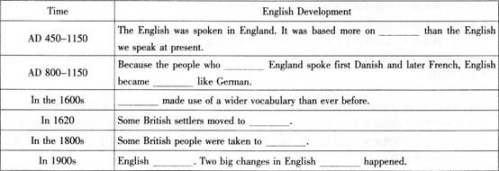
Then the teacher checks the answers.
(Justification: In the process of filling the form, students' reading skill of scanning for the detailed information will be improved, and it will help student understand the text logically.)
Step 3 Post-reading (7 minutes)
Activity 1 Retelling
T: Suppose you are an English teacher, and you have to give a brief introduction of the development of modern English to your students.
Then the teacher asks one of them to show his/her retelling.
Activity 2 Group discussion
The teacher lets students discuss the question why has English changed over time in groups and asks some of them to share their opinions in class.(The answers may vary. But it doesn't matter what their answers may be. The most important thing is to encourage them to express their own thoughts.)
The teacher then makes a summary and emphasizes the importance of learning English.
(Justification: Retelling will make students have a better understanding of the text, and the group discussion will encourage them to express their opinions freely.)
Teaching Contents: The Road to Modern English
Teaching Objectives:
(1) Knowledge objective
Students can learn the development of English and the reasons that English has changed over time.
(2) Ability objective
Students can master predict the content of the text according to the tide and improve their reading abilities through the process of skimming and scanning.
(3) Emotional objective
Students can have a deeper impression of the popularity of English, realize the importance of learning English and have a higher motivation to learn it.
Teaching Key and Difficult Points:
How to make students predict before reading, get the general idea and the specific information while reading.
Major Steps:
Step 1 Pre-reading (6 minutes)
Activity 1 Guessing game
The teacher asks students to guess the meanings of the sentences which are written in old English.
As fair art thou, my bonnie lass,
So deep in luve am I;
And I will luve thee still, my dear,
Till a' the seas gang dry.
Then the teacher explains the background knowledge of the sentences.
(Justification: The guessing game can arouse students' interest in the topic and activate the class attnosphere.
Students will realize that the old English is different from modern English when talking about the meaning of these sentences written in old English, which will get them mentally prepared for the reading comprehension.)
Activity 2 Prediction
Ask students to make a prediction according to the title of the text.
(Justification: Students' predictions will get their mind closer to the theme of the text to be read and make their reading more intriguing and purposeful.)
Step 2 While-reading (12 minutes)
Activity I Skimming
The teacher asks students to read the text, check if they have made the right predictions and try to match the general idea of each paragraph.
Choose one or two groups to show their understanding, give comments and make a summary:
Paragraph 1Many people all over the world speak English.
Paragraph 2Why has English changed over time
Paragraph 3English is now spoken in South Asia.
Paragraph 4Native speakers can understand each other even if they don' t speak the same kind of English.
Paragraph 5Finally by the 19th centurythe language was settled.
Then the teacher checks the answers.
(Justification: This step will help students confirm or reject their predictions and get the main idea of the text.)
Activity 2 Filling in the blanks
The teacher asks students listen to the recording of the text, underline the phrases that have something to do with the time and then fill in the form.

Then the teacher checks the answers.
(Justification: In the process of filling the form, students' reading skill of scanning for the detailed information will be improved, and it will help student understand the text logically.)
Step 3 Post-reading (7 minutes)
Activity 1 Retelling
T: Suppose you are an English teacher, and you have to give a brief introduction of the development of modern English to your students.
Then the teacher asks one of them to show his/her retelling.
Activity 2 Group discussion
The teacher lets students discuss the question why has English changed over time in groups and asks some of them to share their opinions in class.(The answers may vary. But it doesn't matter what their answers may be. The most important thing is to encourage them to express their own thoughts.)
The teacher then makes a summary and emphasizes the importance of learning English.
(Justification: Retelling will make students have a better understanding of the text, and the group discussion will encourage them to express their opinions freely.)
更多“设计任务:请阅读下面学生信息和语言素材.设计一个25分钟的阅读训练活动。 ”相关问题
-
第1题:
根据提供的信息和语言素材设计教学方案,用英文作答。
设计任务:请阅读下面学生信息和语言素材,设计一节课的教学方案。教案没有固定格式,但须包含下列要点:
?teaching objectives
? teaching contents
?key and difficult points
?major steps and time allocation
?activities and justifications
教学时间:45分钟
学生概况:某城镇普通中学九年级(初中三年级)学生,班级人数40人,多数已经达到《义务教育英语课程标准(2011版)》四级水平,学生课堂参与积极性一般。答案:解析:Teaching Content: Talk about the personality and write a personality survey. Teaching Objectives :
Knowledge objective
(1) Key Vocabulary
pretty, social, bother, slight, in the slightest, fairly, plenty, plenty of, get along with, listener
(2) Reading
(3) Writing
Ability objective
Students should improve their ability of reading comprehension and writing.
Emotional objective
Students can learn that being a good listener is an art.
Teaching Key Points:
Master the key vocabulary and the point of writing and reading
Teaching Difficult Point:
How to write a personality survey
Teaching Methods :
(1) Practice method
(2) Pair work
Teaching Aid: A projector
Teaching Procedures :
Step 1 Leading-in (5 minutes)
The teacher asks "what would you do if ...? "
(1) the teacher asked you to give a speech in front of the whole school
(2) your brother borrowed your clothes without permission
(3) someone asked you to be in a movie
(4) you wanted to be friends with a new student
Encourage students to give different answers to each question. Those who speak out the most answers will get a
reward after class.
(Justification: Set a happy English learning atmosphere for students, and make a preparation for today's class.)
Step 2 Presentation (20 minutes)
3a
Show the vocabulary words on the screen by a projector.
pretty adv.相当;颇;非常social adj.社会的;社交的
bother v.打扰:扰乱slight adj.微不足道的;极不重要的
in the slightest一点儿也;根本fairly adv.相当;完全
plenty adj.很多的:足够的plenty of很多的;足够的
get along with与……相处listener n.听者;收听者
Explain the words one by one and have students repeat them several times.
Call students' attention to the personality survey results in the box. Set a time limit of two or three minutes.
Have students read the three paragraphs silently. Meanwhile, write the new words on the blackboard. Ask students to look at the questions and answers on the survey in Activity 2a.
T: The letter "a" answers all describe one type of person. The letter "b" answers describe another and "c" still another type.
Read the Activity 3a instructions to the class. Ask students to reread the personality survey results and decide which letter goes in each paragraph. Point out the sample answer.
Get students to complete the activity on their own.
Check the answers.
3b
Read the instructions to the class.
Invite a student to say the example to the class.
If a friend said something bad about you, would you ...
a. talk to the friend right away?
b. say nothing?
c. think about what he or she said?
T: What kind of person is Question A asking about?
Ss : Outgoing.
T: What about b?Ss: Shy.
T: What about c?Ss: Pretty confident.
T: You are to write your own personality survey. You can write any questions you want, but each question must be about a different personality type.
Give another example on the blackboard. If a friend misunderstood you, would you ...
a. tell him / her it is a misunderstanding at once?
b. want to explain to him / her, but have no courage?
c. invite him / her to dinner and explain?
Get students to work individually. Remind them to use the ones in the book and on the blackboard as a model.
As they work, move around the room checking their works and offering language support.
Part 4
Read the instructions to the class.
Point out the sample conversation in the box. Invite a pair of students to read it to the class.
SA: How many people would talk to the friend right away7
SB: Three. And two people would say nothing.
(Justification: The process of this step provides reading and writing practice using the target, arid introduces key vocabulary words and provides reading practice using the target language.)
Step 3 Practice (15 minutes)
Divide the class into groups of five. Ask students to give their survey to each person in their group, and circle the answers.
T: Having given your survey, talk aboot what you learned. Use the sample conversation in the box as a model.
As the groups work together, walk around the room offering any help they may need.
Ask several students to read his / her question and tell the class about the results.
(Justification: This activity provides oral practice using the target language. )
Step 4 Summary and Homework (5 minutes)
Summary: In this class, we've learned some new vocabulary words. And we've also done much reading and writing practice using the target language.
Homework: Ask students to reread the three paragraphs under the headline personality survey results for further comprehension, and write a personality survery of ten students.
?(Justification:The summary gives a specific conclusion of this class and the homework helps students consolidate the point of the class and improve their writing abilitiy. )
Blackboard Design :
1. Key vocabulary:
?pretty social
?bother slight
?in the slightest fairly
?plentyplenty of
?get along withlistener
2. If a friend misunderstood you, would you ...
?a. tell him / her it's a misunderstanding at once?
?b. want to explain to him / her, but have no courage?
?c. invite him / her to dinner and explain? -
第2题:
根据提供的信息和语言素材设计教学方案。用英文作答。
设计任务:请阅读下面学生信息和语言素材,设计一节听力课的教学方案。教案没有固定格式.但须包含下列要点:?
teaching objectives?
teaching contents?
key and difficult points?
major steps and time allocation?
activities and justifications
教学时间:45分钟?
学生概况:某城镇普通中学七年级(初中一年级)学生,班级人数40人,多数学生已经达到《义务教育英语课程标准(20i l年版)》二级水平,学生课堂参与积极性一般。
语言素材:?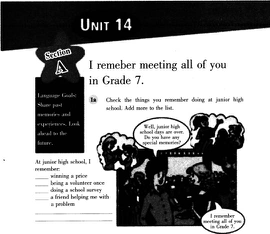
Listen and match the memory with the person.
__ Mary a. used to be scared of a teacher with high standards.
__ Frank b. remember losing a schoolbag.
__ Sarah c. remembers meeting this group of friends.
__ Peter d. has enjoyed every year of junior high school.
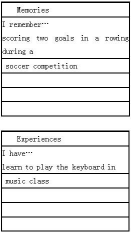 答案:解析:Teaching Content: A listening material about "I remember meeting all of you in Grade 7".
答案:解析:Teaching Content: A listening material about "I remember meeting all of you in Grade 7".
Teaching Objectives:
(1) Knowledge objectives
①Students can consolidate the usage of remember and the sentence pattern "I remember doing sth".
② Students can be more familiar with the topic of memories.
(2) Ability objectives
According to study, students can improve their skills of listening for specific information and can talk about the meaningful and unforgettable memories in English freely.
(3) Emotional objectives
① Students can find out some meaningful memories from the past experience to encourage themselves studying hard.
②Students can understand we should cherish present and do our best to create a bright future.
③ Students can improve the confidence of learning English, and are not afraid of speaking English.
Teaching Key Points:
How to make students improve their skills of listening for specific information.
Teaching Difficult Point:
How to make students use the knowledge they learnt before to talk about the things happened in the past.
Teaching Aids: a tape recorder, multimedia, pictures
Teaching Methods: Communicative Approach, Task-based Teaching Method, Audio-Lingual Approach.
Teaching Procedures:
Step 1 Lead-in (5 minutes)
The teacher shows some photos about students' junior high school and play the music named"Seasons in the Sun" to let students look back on their junior high school memories, and told them today they are going to learn to express their memories in English.
T: (after listening) Now, who can tell me what's the subject of this song
S: About youth.
T: Yes, it's about youth. Very good. This is the last unit of our English book. In this unit, we will mainly talk about our past school lives.
(Justification: This step could attract students' attention and lead in the new lesson easily.)
Step 2 Pre-listening (10 minutes)
Teacher asks students to look at the picture in this unit, and asks students to finish the task in la. Then asks students to check the things they remember doing at junior high school and add more things they remember as much as possible.
T: Now, look at the picture. What kind of party do you think it is Is it a welcome party or graduation party
S: Graduation party.
T: Look at the small pictures. What are the boy and girl talking about Try to guess!
S: (Discussing)
T: OK. Let's look at the small scenes in this big picture. What does the girl remember doing According to the pictures, please have a guess and finish the task in la. Do you understand
S: Yes!
T: And you are supposed to write down some more items about what you remember doing in your past school time. Ok, now, let's do it.
(Justification: This step can attract students' attention and help and encourage them to foucus on the content of what they are about to hear.)
Step 3 While-listening (13 minutes)
(1) Teacher asks students to listen to the tape and match the memory with the person. Then asks them to tell their answers to their partners.
T: Ok, now, let's move on to our listening. Listen to the tape and match the memory with the person. And tell your answer to your partner by using sentences, such as, Peter remembers doing homework carefully to meet the standards of a strict teacher. Are you clear
S: Yes!
T: Now, let's begin!
Students listen to the tape.
T: Ok, now, who can tell us your answers
SI: Sarah remembers losing a schoolbag ...
T: Ok, very good. Sit down, please.
$2: ...
(2) Then the teacher plays the tape again, and asks students to read after the record.
T: Now, I will play the record again and you are supposed to read after the record silently. Any questions
S: No.:
T: Ok, now, please listen to the tape. While listening, please pay more attention to the pronunciation and
intonations.
(Justification:This step make students listen and enjoy what they are listening. The task of matching the memorizing and with the person makes students focus on the listening itself. )
Step 4 Post-listening (12 minutes)
(1) The teacher asks students to make a dialogue with their deskmates by using the list in la.
T: Now, you are supposed to make a dialogue with your deskmate according to the list you wrote in la. Here is a conversation structure, you can make your dialogue according to it.
(Then the teacher writes the example on the blackboard.)
Example:
--What do you remember doing
--I remember doing my homework very late till to 12 o'clock. What do you remember doing
--Well, I remember winning a prize. And my parents took me to the biggest amusement park in our city.
--Wow!It's cool. What else do you remember
--I still remember playing basketball on the playground with you and singing songs with our best friends.
--Yes, wonderful and colorful.
The teacher chooses one student and his/her deskmate to present their dialogue in front of the class and gives
some feedback.
(2) T: Now, look at the chart on PPT, I need you to make an interview. Interview some classmates and record at least three memories of thetn. Then fill the chart and make dialogue with your deskmates. Any questions
S: No.
T: Good. Let's do it. After finished, I will invite three groups to share their dialogues, and the best group will get a reward.
(Justification: This step is easier for students' to have a high motivation to speak. According to their make dialogue with their deskmates can test the students' listening comprehension.)
Step 5 Summary and Homework (5 minutes)
Summary: Ask students to think about the key sentence structures they listened today, and then make a short summary.
Homework: Ask students to look back on their school life, and communicate these colorful feelings with their friends.
Blackboard Design:
Unit 14 I remember meeting all of you in Grade
Pre-listening:
While-listening:
Post-listening:
Example:
--What do you remember doing
--I remember doing my homework very late till to 12 o'clock. What do you remember doing
--Well, I remember winning a prize. And my parents took me to the biggest amusement park in our city.
--Wow!It's cool. What else do you remember
--I still remember playing basketball on the playground with you and singing songs with our best friends.
--Yes, wonderful and colorful.
Teaching reflection. -
第3题:
根据提供的信息和语言素材设计教学方案。用英文作答。
33.设计任务:请阅读下面学生信息和语言素材,设计一节英语听说课的教学方案。教案没有固定格式,但须包含下列要点:
·teaching objectives
· teaching contents
· key and difficult points
· major steps and time allocation
· activities and justifications
教学时间:45分钟
学生概况:某城镇普通中学八年级(初中二年级)学生,班级人数40人,多数已经达到《义务教育英语课程标准(2011版)》四级水平,学生课堂参与积极性一般。
语言素材:
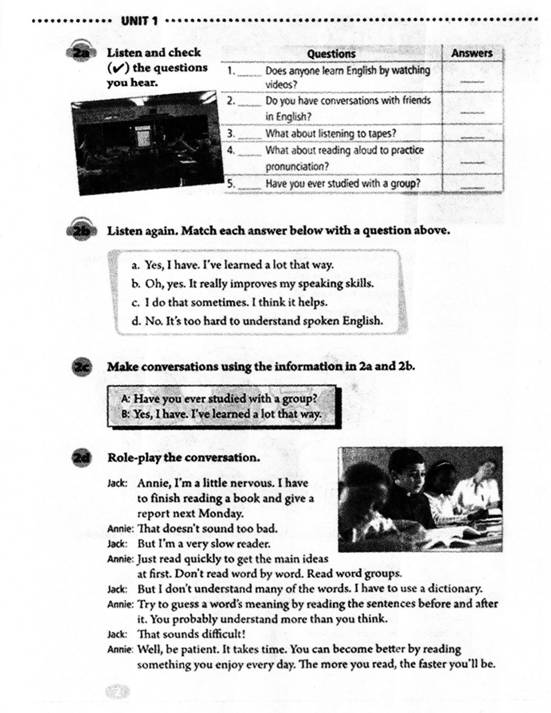 答案:解析:Teaching Content: This lesson is about the new sentence pattern"by doing". It can help the students to talk about how they study. Teaching Objectives :
答案:解析:Teaching Content: This lesson is about the new sentence pattern"by doing". It can help the students to talk about how they study. Teaching Objectives :
( 1 ) Knowledge objective
Students could master some expressions of English learning methods and sentence patterns like "I study ... by ...".
(2) Ability objective
Students could talk about how to learn English and describe their study in sentence pattern "by doing".
(3) Emotional objective
Students could help others to learn English while communicating. It can strengthen their confidence.
Teaching Key Points:
(1) Master the usage of sentence patterns like "How do you study ... I study ... by ...".
(2) Express their ideas in the "by doing" structure.
Teaching Difficult Points:
Describe English learning methods with abundant vocabulary and use these methods effectively.
Teaching Aids :
Multi-media, some related pictures.
Teaching Procedures :
Step 1 Leading in and Warming up (5 minutes)
The teacher will play a video and lead in the topic"learning to learn". Students will talk about some learning methods they know with the language structure "by doing"
(Justifications: Playing a related video will help students recall their old times of studying and make preparations for the next step.)
Step 2 Presentation (10 minutes)
(1) Students use the pictures on Page 1 to predict phrases about learning methods with the language structure "by doing".
(2) Students will do exercise from la.
(Justifications: Students will understand the usage of"by doing" better through this part. They can also master some phrases related to English learning methods.)
Step 3 Listening (10 minutes)
Students will do some listening exercises from lb, 2a and 2b. They can gain some methods to learn English while listening.
(Justifications: Students will know the usage of"by doing" completely through listening materials. Also, they can imitate pronunciation from listening materials and gain key phrases from listening exercises.)
Step 4 Practice (10 minutes)
Two students work in a group to do a conversation exercise according to the content from 2a and 2b.
(Justifications: Students can practice making conversations according to listening materials and enhance their understanding of the usage of "by doing".)
Step 5 Consolidation (5 minutes)
Two students work in a group to practice the conversation. Then change their roles.
(Justifications : Students will enhance their understanding of English learning and improve the skills of listening and speaking.)
Step 6 Summary and Homework (5 minutes)
Summary: Students will recall what they have learned today. The teacher can repeat them.
Homework: Students will do some exercise on the textbook and make sentences with "by doing".
(Justifications: This will help students recall what they have learned today and check whether they have mastered the knowledge.)
Blackboard Design :
New sentence patterns:
How do you study for a test
I study by working with a group. -
第4题:
设计任务:请阅读下面学生信息和语言素材,设计一节英语阅读课教学方案。
教案没有固定格式,但须包含下列要点:?
teaching objectives
teaching contents
key and difficult points
major steps and time allocation
activities and justifications
教学时间:45分钟?
学生概况:某城镇普通中学高中一年级第二学期学生,班级人数40人。多数学生已经达到《普通高中英语课程标准(实验)》五级水平。学生课堂参与积极性一般。
语言素材:?
The trick of eating healthily is remembering that no food in itself is good or bad; eating properly depends on eating the right variety of food in the right amount. Too much of even the most"healthy" food can lead to illness and disorders.
If you like a snack, avoid chocolate and crisps and head for fruit, filled rolls, soup and baked potatoes instead. Sugar-free breakfast cereals are also a good bet. 答案:解析:Teaching Contents: It is about eating healthily and several scientific eating habits. It also offers recommending servings per day.
答案:解析:Teaching Contents: It is about eating healthily and several scientific eating habits. It also offers recommending servings per day.
Class Type: Reading class, 1 period
Teaching Objectives:
( 1 ) Knowledge objective:
Students can master the following words and expressions: healthy, heahhily, amount, snack, bake, recommend,provide, variety, lead to.
(2) Ability objectives:
①Students can develop their reading ability by skimming and scanning practice.
② Students can improve the speaking ability by talking about scientific and healthy eating habits.
(3) Emotional objective:
Students can develop scientific and healthy eating habits and learn to live a healthy life.
Teaching Key Points:
(1) How to help students master the following words and expressions like healthy, healthily, amount, snack,bake, recommend, provide, variety, lead to.
(2) How to make students improve their reading and speaking skills.
Teaching Difficult Point:
How to guide students to develop a healthy eating habit.
Teaching Aid: multi-media
Teaching Procedures:
Step 1 Warming up and lead-in (5 minutes)
Brainstorm: Questions and answers
The teacher asks students the following questions.
( 1 ) What do you eat every meal List the" food.
(2) Do you eat healthily
(Justification: This step will help students to combine English learning with daily life, and at the same time it will arouse students' interest in learning this lesson.
Step 2 Pre-reading (5 minutes)
The teacher asks students to discuss their opinions on eating properly. Then the teacher introduces the topic about healthy eating.
(Justification: This step will help students know about what healthy and proper eating is.)
Step 3 While-reading (23 minutes)
(1) Fast reading (7 minutes)
The teacher asks students to read the text quickly and fill in the blanks according to the text.
(2) Intensive reading (16 minutes)
The teacher lets the students read the text and do the True or False exercises:
① Eating properly means eating only the right variety of food. ( )
② Eating too much healthy food has no bad effects on health. ( )
③ Soup, baked potatoes, crisps and chocolate are available for snacks. ( )
④ Milk, cheese and yoghurt are good for our health, so we can choose the low fat varieties and have 2 to 3 servings every day. ( )
⑤ In order to keep healthy, we should eat fruit and vegetables everyday without limit. ( )
(Justification : This step will help students have a further understanding of the text.)
Step 4 Post-reading (7 minutes)
The teacher divides students into several groups, and gives them an assignment. Students can first discuss it in groups, give their own opinions and choose a member to present their opinions to the whole class.
Assignment: Suppose you are a cook in our school canteen. What dishes would you serve on Tuesday List out your dishes and explain the reasons.
(Justification: The group work could practice students'ability of speaking and develop their spirit of cooperating with others. )
Step 5 Summary and Homework (5 minutes)
Summary: The teacher summarizes what they have learnt in this class.
Homework: The teacher asks the students to share what they have learnt about healthy food with their parents.
Meanwhile, the teacher asks the students to interview their parents about their opinions on healthy eating, and then next class the teacher will ask several students to share their interviewing reports with the whole class.
(Justification: Students can review and consolidate what they have learnt in this class.)
Blackboard Design:
Key words and expressions:
healthy, healthily, amount, snack, bake, recommend, provide, variety, lead to
Recommended servings her day Teaching Reflection. -
第5题:
设计任务:请阅读下面学生信息和语言素材,设计20分钟英语阅读的教学教案没有固定格式,但须包含下列要点:
●teaching objectives
●teaching contents
●key anddifficult points
●majorsteps and time allocation
●activities and justifications
教学时间:20分钟
学生概况:某城镇普通中学高中一年级学生,班级人数40人。多数学生已达到《普通高中英语课程标准(实验)》五级水平。学生课堂参与积极性一般。
 答案:解析:Class Type:ReadingClass
答案:解析:Class Type:ReadingClass
TeachingContents:The lesson mainly talks about the ThreeGorges Dam, including its features, advantages and disadvantages.
Teaching Objectives:
Knowledge objective
Students can get more information about the features, advantages anddisadvantages of the Three Gorges Dam.
Abilityobjectives
(1)Students can understand the main content and detail information ofthe passage through fast reading and detailed reading.
(2)Students can introduce the Three Gorges Damin their own words.
Emotional objective
Students can develop a sense of national pride through learning thispassage.
Teaching Key and Difficult Points:
Studentscan get a general idea of the passage and learn to use reading strategies tounderstand the material, such as summarizing, skimming and acquiring usefulinformation
Major Steps:
Step1 Pre-reading (5 minutes)
1. Show a poem of Mao Zedong on PPT:Walls of stone to hold back clouds and raintill a smooth lake rises in the narrow gorges.Students guess which placeit is. Then show some beautiful pictures of the Three Gorges Dam.
2. Students have a discussion: Why did weChinese build the Three Gorges Dam Then ask some of them to share their ideas.
(Justification: The poem and pictures canarouse students' interest in this class. Discussion will stimulate students’ backgroundinformation and students will get prepared for the reading class, and it willbe helpful to understand the material. )
Step 2 While-reading (9 minutes) .
1. Fast reading: Task 1 : Students read the passage quickly and give asummary of each paragraph. Students share their ideas and help students toanalyze the article structure.
2. Careful reading: Task 2: Students read the passage again and completethe following table. Then ask some students to show their answers and giveassessments.

Task3 : Students pay attention to Paragraph 2-5, and work in pair s to discuss thequestions below:
(1) What's the biggest advantage of the Three Gorges Dam project
(2) What has happened to the historical relics near the Three GorgesDam
Ask some pairs to show their opinions and lead students t0 1eam thenecessity of the Three Gorges Dam.
(Justification: Through three tasks, students can have a thoroughunderstanding of the passage, and improve reading skills by using different readingstrategies: such as summarizing and acquiring useful information.)
Step 3 Post-reading (6 minutes)
Interview: students work in a group of three. Two students act asengineers from the Three Gorges Dam and one student as a reporter. The reporterasks some questions about the Three Gorges Dam and their feelings about the constructionproject. After three minutes, invite some groups to show their dialogues.
(Justification: Students can improve their speaking ability by talkingabout the Three Gorges in their own words and develop a sense of national pride.) -
第6题:
根据提供的信息和语言素材设计教学方案,用英文作答。
设计任务:请阅读下面学生信息和语言素材,设计一节英语读写课的教学方案。教案没有固定格式,但须包含下列要点:?
teaching objectives
teaching contents
key and difficult points
major steps and time allocation
activities and justifications
教学时间:45分钟?
学生概况:某城镇普通中学七年级(初中一年级)学生,班级人数40人,多数已经达到《义?
务教育英语课程标准(2011版)》二级水平,学生课堂参与积极性一般。
Listen and write these city names in the boxes above.
Beijing Moscow Toronto Boston Shanghai
Imagine you are in one of the placesin la. Talk about the weather with your friend on the phone. 答案:解析:【参考设计】
答案:解析:【参考设计】
Teaching Contents: A lesson about describing the weather.
Teaching Objectives:
Knowledge objectives
(1) Students could have a good command of these following words.
rain, windy, cloudy, sunny, snow, weather
(2) Students could master these following sentence patterns.
How' s the weather
It's cloudy./It's sunny./It's raining.
Ability objective Students could know how to describe the weather.
Emotional objectives
(1) According to the guide of teaching, students could cultivate the good habits of protecting environment and other natural resources.
(2) According to talk about the weather, students could learn how to get on well with others.
Teaching Key Points:
Master the vocabularies and sentence patterns expertly.
Teaching Difficult Point:
Learn how to describe different weather in different places.
Teaching Aid:
Multi-media
Teaching Procedures :
Step I Lead-in (5 minutes)
The teacher uses multi-media to present some pictures of different weather.
T:"There are many different weather in different seasons. Different weather has different meanings to our life.
This class we will learn the weather. Now everyone has to speak out different kinds of weather as many as possible and the one who speak out the most will get a red paper star."
(Justification: These pictures on the screen can help students to know what they will learn this class. The brainstorming will stimulate their interests and incentives. )
Step 2 Presentation (15 minutes)
(1) The teacher plays the tape and asks them to listen to the tape recorder and guess the weather. At the same time, write the important sentence pattern "How's the weather " on the blackboard.
(2) Guide students to observe the weather in the five places and finish la.
(3) Make students listen to the tape, and then write the right places (lb) in the boxes above (la).
(Justification: At this step, their ability of listening for specific information will be well developed, and their participation will increase. The teacher also could guide them to speak out the key sentences.)
Step 3 Practice (10 minutes)
(1) Pair work
①Two students in a pair, speak out the weather in the five places, and check the answer of lb.
② Make a dialogue to ask the weather.
S1: How's the weather
$2: It's rainny. How's the weather in Beijing
SI: It's sunny.
(2) Group work
The teacher gives a sentence pattern"Look!The weather in ... is ...". Let students complete the sentence by using the words they have learned. Ten students in a group, which group do the best in ten minutes will be given some gifts after the class.
(Justification: This step is mainly to practice their speaking and listening skills by putting the knowledge into their daily life. This activity can let them enjoy the study.)
Step 4 Consolidation (lO minutes)
Students should write down the words they have heard from the teacher. Then check the words, if there is a mistakes, they need more practice after class.
(Justification: This step will deepen students' impression of these words and make students realize their mistakes. It's also make students know how to review after class.)
Step 5 Summary and Homework (5 minutes)
Summary: The teacher asks one student to give a summary for this class.
Homework: The teacher asks students to review the new words they have learned in this class and try to make sentences using them.
(Justification: Summary can help students to consolidate the knowledge what they have learned in the class and the homework gives a guidance for review.)
Blackboard Design:
Words: Sentences:
rain, windy, cloudy, How's the weather
sunny, snow, weatherIt's cloudy./It's sunny./It's raining.
Teaching Reflection. -
第7题:
根据提供的信息和语言素材设计教学方案,用英文作答。
设计任务:请阅读下面学生信息和语言素材,设计20分钟的英语听说教学方案。
该方案没有固定格式,但须包含下列要点:
·teaching objectives
·teaching contents
·key and difficult points
·major steps and time allocation
·activities and justifications
教学时间:20分钟
学生概况:某城镇普通中学初中一年级(七年级)学生,班级人数40人,多数学生已经达到《义务教育英语课程标准(2011年版)》二级水平。学生课堂参与积极性一般。
语言素材: 答案:解析:Teaching Contents: These three passages are about the descriptions of friends and the things they do together.
答案:解析:Teaching Contents: These three passages are about the descriptions of friends and the things they do together.
Teaching Objectives:
(1) Knowledge objectives
Students can learn some new words and expressions such as "chubby, athletic" to describe a friend's appearance,character, interests and what they like to do.
(2) Ability objectives
①Students can develop the ability to describe a friend' s appearance, character, interests and what they like to do.
②Students can improve their listening and speaking skills.
(3) Emotional objectives
Students can get a deeper understanding about friendship and strengthen the friendship with friends.
Teaching Key and Difficult Points:
(1) How to make students learn to describe a friend.
(2) How to make students improve the listening and speaking skills.
Major Steps:
Step 1 Pre-listening (5 minutes)
The teacher asks students the following questions:
(1) Who is your best friend What does he/she look like'
(2) What does he/she like to do What do you usually do
(Justification: Questions about students' friends can arouse their interest and prepare them for the class.)
Step 2 While-listening (9 minutes)
(1) Listen to the tape and fill in the blank.
(2) Listen to the tape again and finish the following question of each person: What do you like to do together
(Justification: This step helps students to get a better understanding about the listening material.)
Step 3 Post-listening (6 minutes)
(1) Show the tape scripts on the PPT.
(2) Group discussion: Talk about your ideal friends.
Then the teacher asks some students to share their ideas, then makes a conclusion about friendship andemphasizes the importance of friendship.
(Justification: This step helps students to train their speaking abilities and further their understanding aboutfriends and friendship.)
(备注:本方案设计是按照PWP模式设计的,以“听力”为主线,在听的过程中穿插“说”的活动,以提升学生的听说能力,也可以依据3P模式进行设计。) -
第8题:
阅读下面材料,根据要求完成教学设计。
要求:请根据思想政治辩论式教学的相关要求,结合教学内容设计一个辩题,并围绕该辩题设计教学活动简案。答案:解析:辩题:传统文化是财富还是包袱 教学活动简案:
①活动目标:
正确看待传统文化的作用,树立对待传统文化的正确态度。
②活动准备:
a.确定正方观点以及正方选手。正方观点:传统文化是财富。
b.确定反方观点以及反方选手。反方观点:传统文化是包袱。
c.正方和反方就各自的观点搜集材料,为辩论做好充分准备。
③活动过程:
a.正方一辩陈述立论。
b.反方一辩陈述立论。
c.正方二辩选择反方二辩或三辩进行一对一攻辩。
d.反方二辩选择正方二辩或三辩进行一对一攻辩。
e.正方三辩选择反方二辩或三辩进行一对一攻辩。
f.反方三辩选择正方二辩或三辩进行一对一攻辩。
g.正方一辩进行攻辩小结。
h.反方一辩进行攻辩小结。
i.自由辩论。
i.反方四辩总结陈词。
k.正方四辩总结陈词。
l.观众提问。
④活动总结:
教师对双方的辩论技巧、逻辑推理、语言表达能力等多个方面进行总结,让学生明白反对什么,提倡什么。通过对“传统文化是财富还是包袱”的辩论,使学生能够辩证地认识传统文化在现实生活中的作用,分辨其中的精华和糟粕,树立对待传统文化的正确态度,即“取其精华、去其糟粕”,批判继承,古为今用。 -
第9题:
请认真阅读下列材料,并按要求作答。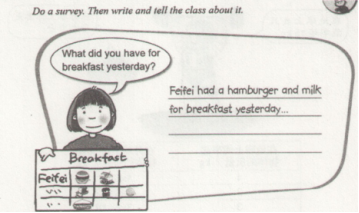
请根据上述材料完成下列任务:
(1)简述如何激发小学生的写作兴趣。
(2)如指导小学生学习,试拟定教学目标。
(3)依据拟定的教学目标,设计导入和写前环节的教学活动并说明设计理由。答案:解析:(1)激发小学生写作兴趣的措施 ①开展丰富多彩的实践性活动,以生动活泼的形式去激发学生的写作兴趣,帮助学生消除畏难情绪,使学生敢于写。
②引导学生观察生活,并引导学生阅读学习一些写作素材,使学生有话可写。
③采取有效的激励措施,激发学生的写作兴趣,如开展作文评比活动、优秀作文赏析活动等,使学生乐于写。
(2) Teaching Aims
Knowledge aim: Students can have a better understanding of how to write short passages.
Ability aim : Students can write and talk about their diet plan in their daily life.
Emotional aim : Students become more interested in English and know the importance of keeping a healthy diet.
(3)导入和写前环节
Warming up and lead-in:
①Daily greeting.
②Show some food on PPT and ask students what their favorite food are and why.
【设计意图】
从生活角度出发,有利于激发学生的学习兴趣,提高课堂参与度,营造学习氛围。
Pre-writing :
The teacher firstly tells the students the writing topic. And then they need to have a talk about their food forbreakfast. After that, the teacher can provide some useful words and sentence patterns. And also the teacher canshow a writing model, which includes a basic structure.
【设计意图】
写前交代清楚所写话题及所涉及的一些词汇、句式结构等,有利于帮助学生消除畏难情绪,激发学生的写作欲。 -
第10题:
请认真阅读下列材料,并按要求作答。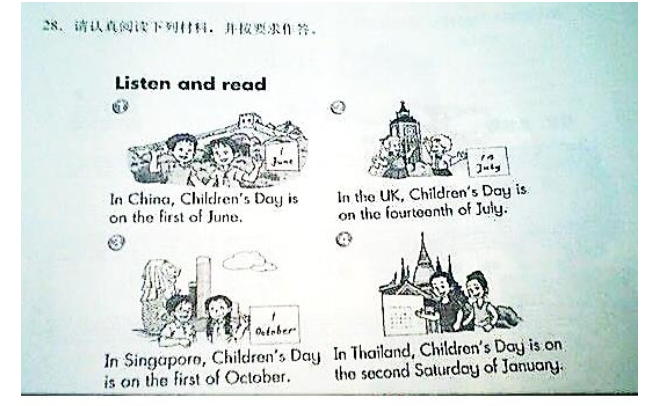

请根据上述材料完成下列任务:
(1) 简述学生综合语言运用能力形式的基础。(10 分)
(2) 如指导小学生学习,试拟定教学目标。(10 分)
(3) 依据拟定的教学目标,设计导入和新授环节的教学活动并说明理由。(20 分)答案:解析:本题考查小学英语教学设计。
(1)综合语言运用能力的形成建立在语言技能、语言知识、情感态度、学习策略和文化意识等方面整体发展的基础之上。语言技能和语言知识是综合语言运用能力的基础,学生在义务教育阶段应该学习和掌握的英语语言基础知识包括语音、词汇、语法以及用于表达常见话题和功能的语言形式等。语言知识是语言运用能力的重要组成部分,是发展语言技能的重要基础。语言技能是语言运用能力的重要组成部分。语言技能主要包括听、说、读、写等方面的技能以及这些技能的综合运用能力。听和读是理解的技能,说和写是表达的技能。它们在语言学习和交际中相辅相成、相互促进。
学生应通过大量的专项和综合性语言实践活动,形成综合语言运用能力,为真实语言交际打基础。因此,听、说、读、写既是学习的内容,又是学习的手段。语言技能目标以学生在某个级别“能做什么”为主要内容,这不仅有利于调动学生的学习积极性,促进学生语言运用能力的提高,也有利于科学、合理地评价学生的学习结果。
(2) Teaching Aims:Knowledge aims:
①Students can master the new words“Singapore,Thailand,UK,Japan”.
②Students can master the sentence structures“Children’s Day is on the...day of...”
③Students can learn the different customs and date of Children’s Day in different countries.
Ability aims:
①Students are able to answer the customs and date of Children’s Day in different countries correctly.
②Students are able to learn to talk about Children’s Day with others.Emotional aims:
①After this lesson students would like to learn more festivals customs of different countries.
②Students can be more interested in learning English and sharing their knowledge obtained with others.
(3) Step1 Warming up&Lead in
1.Daily greeting.
2.Play the song for the students and ask the question “When is your birthday?”
3.Play the type of celebrations of children’sday, and ask students think when is China’ children’s day?
(设计意图:营造和谐的英语学习气氛,使学生带着愉快的心情进入学习状态。通过儿歌激发
兴趣,建立融洽的师生渠道,激发学生思维,唤醒学生对日期表达法的记忆,同时复习旧知。)
Step2 Presentation
(1) Words learning.
①Look and Guess
Write down the new words on blackboard.
Teacher uses the flags and the pictures of people of different countries to explain the new words(Singapore,Thailand,UK,Japan)and ask students to guess.Once they come up with the right answer, rewards will be given.
②Point and say
Ask one student to say a new word they just learnt, and another student needs to point the picture on
the blackboard.(设计意图:通把图片和单词进行匹配,学生可以更容易的记住这些新单词的含义,
进而也为学生理解课文的内容做好了铺垫。)
(2) Sentence learning.
①Ask students “When is China’ children’s day?” and explain the sentence in Chinese. Help students to answer “In China, Children’s day is on the first of June.” Those target language need to be written on blackboard.
②Lead students to read the passage and explain the meaning of each sentence in the mean time.
③Then play the video of the passage and ask students to do the ture and false.(设计意图:通过展示
学生熟悉的中国儿童节来开展对话,易于学生理解其他国家儿童节的日期,同时,通过朗读课文和
解释句子含义,加深了学生对新句型的理解,同时学生能理解不同国家的儿童节在不同的时间,但
是含义都一样。进而理解不同国家的文化差异。) -
第11题:
问答题请认真阅读下列材料,并按要求作答。请根据教学目标设计一个语言运用活动,并说明设计意图。(要求:创设一个真实语境,让学生运用核心句型以小组活动的形式进行语言交际训练。)正确答案: Practice&ActivityWorkingroupof4,andgiveeachgroupanemptyboxanda"Lost&Found"board.Studentscanputtheirstationeriesintheemptybox.Thenonestudentactsasanofficestaff;otherstudentscometohimtogettheirlostthingsback.Forexample:A:Exeuseme.Ilostmypencilbox.B:Whatcolorisit?A:It'sredandblue.B:OK.What'sinit?A:Twopencils,apen,arulerandaneraser.B:Hereitis!A:Thankyousomuch.Studentswillhave10minutestocompletethedialogue.Aftertheyhavefinishedthegroupwork,inviteoneortwogroupstocometothefrontandshowtheirdialoguestothewholeclass.Teacherwillgivethemproperfeedback.(设计意图:通过创设情境,让学生通过小组活动来练习单词和句型,可以提升学生的学习兴趣,使学生在合作交流的过程中巩固新知,增强合作意识。)解析: 暂无解析 -
第12题:
单选题设计任务:请阅读下面学生信息和语言素材,设计20分钟的英语听力教学方案。该方案没有固定格式,但须包含下列要点:●teaching objectives●teaching contents●key and difficult points●major steps and time allocation●activities and justifications教学时间:20分钟学生概况:本班为中等城市普通学校初中一年级(七年级),班级人数45人。多数学生已经达到《义务教育英语课程标准(2011年版)》二级水平。学生能够积极参与课堂活动,合作意识较强。语言素材:AHow much is the hat?
BLet's see. The sweater is nine dollars.
正确答案: A解析: -
第13题:
根据提供的信息和语言素材设计教学方案。用英文作答。
设计任务:请阅读下面学生信息和语言素材,设计一节英语听说课的教学方案。
教案没有固定格式,但须包含下列要点:?
teaching objectives
teaching contents
key and difficult points
major steps and time allocation
activities and justification
教学时间:45分钟?
学生概况:某城镇普通中学七年级(初中一年级)学生,班级人数40人,多数学生已经达到?
《义务教育英语课程标准(2011年版)》二级水平,学生课堂参与积极性一般。
语言素材:?
Interviewer: Scott has an interesting job. He works at a radio station. Scott, what time is your radio show?
Scott: From twelve o'clock at night to six o'clock in the morning.
Interviewer:. What time do you usually get up?
Scott: At eight thirty at night. Then ! eat breakfast at nine.
Interviewer: That's a funny time for breakfast!
Scott: Yeah. After that, I usually exercise at about ten twenty.
Interviewer: When do you go to work?
Scott: At eleven o'clock I so I'm never late for work. 答案:解析:【参考设计】
答案:解析:【参考设计】
Class Type: Listening and speaking class
Teaching Contents: A dialogue between the interviewer and Scott about Scott's daily routine.
Teaching Objectives:
Knowledge objectives
(1) Students can master the following words and expressions: radio station, usually, funny, exercise.
(2) Students can use the following sentence patterns:
①What time do you usually ...
② When do you ...
Ability objectives
(1) Students can improve their listening ability by listening to the dialogue.
(2) Students can improve the speaking ability by talking about what they usually do in a day.
Emotional objectives
Through this class, students can know something about radio workers' jobs and respect them.
Teaching Key Point:
How to help students master the new words, expressions and the usage of the sentence patterns.
Teaching Difficult Point:
How to make students master the words and expressions and improve their speaking and listening skills.
Teaching Aid: multi-media
Teaching Procedures:
Step 1 Wanning up and Lead-in (5 minutes)
The teacher greets the students and asks them two questions. The first question is "What are your parents'jobs " and the second is "Do you know something about the job of a radio host " Then the teacher tells the students that Scott has an interesting job and asks them to listen to the text and get to know about Mr. Scott.
(Justification: This step can get students to combine English learning with their daily life. Also, it's easy for them to say something about their life.)
Step 2 Listening (15 minutes)
The teacher asks students to listen to the tape for the first time with the following questions. After that, asks students to try to answer the questions. Then, the teacher asks them to listen to the tape for the second time with the purpose to repeat it.
① Where does Mr. Scott work
②Does he eat breakfast in the morning as common people Why
③ When does he go to work
④Is he usually late for work
(Justification: This step can get students to have a further understanding of the dialogue.)
Step 3 Practice and Consolidation (20 minutes)
(1) Practice the sentence patterns (10 minutes)
The teacher selects an example in the dialogue, points out the sentence patterns and then makes students to make their own sentences according to the example.
Sentence Pattern 1. --What time do you usually ... --I usually ...
Sentence Pattern 2. --When do you ... --I ...
Examples: ① --What time do you usually get up
--I usually get up at 7 am.
② --When do you go to work
--I go to work ...
(Justification: This step can get students to master the sentence patterns.)
(2) Making an interview (10 minutes)
The teacher asks two students in pair. One student acts as an interviewer and the other acts as an interviewee.
The interviewer makes an interview about the interviewee's job. The interviewee should use the above sentence patterns.
(Justification: Students act out the dialogue in their own way, which helps to consolidate what they have learned in this class.)
Step 4 Summary and Homework (5 minutes)
Summary: The teacher asks one student to summarize what he/she has learned in this class.
Homework: The teacher asks students to do exercises of this part on the exercise book.
(Justification: Students can review and consolidate what they havelearned in this class.)
Blackboard Design:
Words and Expressions: radio station, usually, funny, exercise.
Sentence Patterns:
① What time do you usually ...
② When do you ...
Teaching Reflection. -
第14题:
根据提供的信息和语言素材设计教学方案,用英文作答。
设计任务:请阅读下面学生信息和语言素材,设计15分钟的英语听说教学方案。教案没有固定格式,但须包含下列要点:
●teaching objectives
●teaching contents
●key and difficultpoints
●major steps and timeallocation
●activities andjustifications
教学时间:15分钟
学生概况:某城镇普通中学七年级(初中一年级)学生,班级人数40人。多数学生已经达到《义务教育英语课程标准(2011年版)》二级水平。学生课堂参与积极性不高。
语言素材:
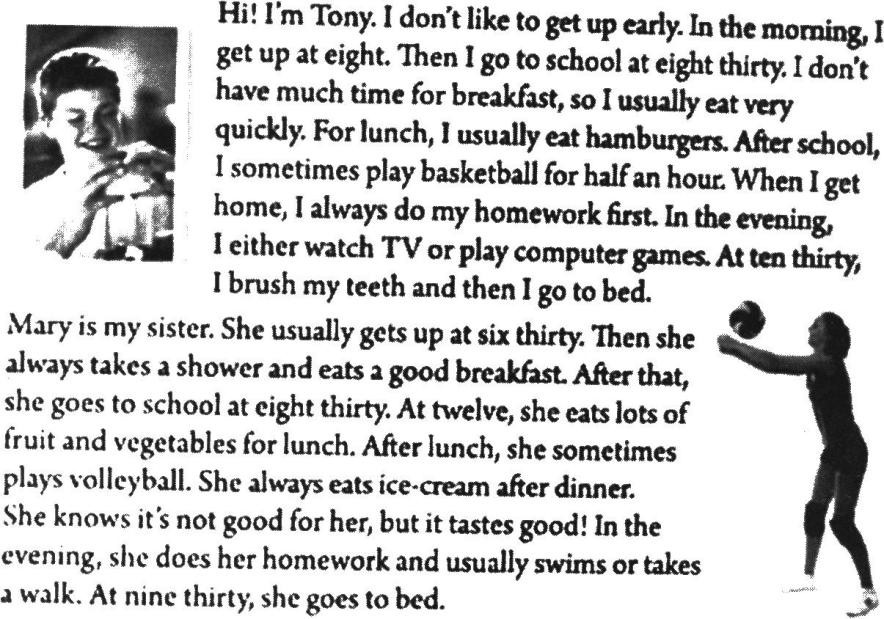 答案:解析:Ⅰ.Class Type: Listening and Speaking Class
答案:解析:Ⅰ.Class Type: Listening and Speaking Class
Ⅱ.Teaching Contents: The passage is about habitsof Tony and Mary.
Ⅲ.Teaching Objectives:
(1) Knowledge objectives
①Students can master themeaning and usage of frequency words:usually, always and sometimes.
②Students can review the usage of simple presenttense.
(2) Ability objectives
①Students can understandthe main content and grasp detailed information of the listenning material byusing different listening strategies, such as summarizing and selectivelistening..
②Students can use simplepresent tense to talk about their daily activities.
(3) Emotional objective
Students can learn theimportance of good habits and cultivate healthy habits.
Ⅳ.Teaching Key andDifficult Points:
(1) Teaching key points
①Students can get themain topic and specific information of the material.
②Students can use thewords and simple present tense to talk about their daily activities (2)Teaching difficult point
Students can apply listening strategies, such assummarizing and selective listening and listening for specific information inlistening practice.
Ⅴ.Major Steps:
Step 1 Pre-listening(3minutes)
Ask students somequestions as following to share their daily life in group of four, and choosethree representatives to share their ideas.
(1) What time do youusually get up on school days
(2) What time do youhave breakfast
(3) Do you have somehealthy/unhealthy habits
(Justification: Throughgroup discussion, students can get farmiliar with the topic, and strengthentheir cooperative spirit and speaking abilities.)
Step 2 While-listening (8minutes)
1.Extensive listening
Ask students to listen tothe tape for the first time and answer the question: What is the main idea ofthe listening material
2. Listen to the tapeagain and respectively circle the activities Tony and Mary do.
3. Intensive listening
Ask students to 1istento the tape for the second time and fill in the following table.

(Justification: Throughextensive listening, students will grasp the main content of this listeningmaterial and through intensive listening, students will enhance their abilityof grasping specific information.)
Step 3 Post-listening (4minutes)
l. Read the script afterthe tape.
2. Interview : Askstudents to work in a group of 3 and interview their partners about theirhabits. Invite some volunteers to make a report in the front of the class andgive them feedback.

(Justification: Students can realize the importance of cultivatinga good habit, develop their listening and speaking abilities and enhance theirawareness of cooperating with others.) -
第15题:
根据提供的信息和语言素材设计教学方案。用英文作答。
设计任务:请阅读下面学生信息和语言素材,设计一个30分钟的写作教学活动。
教案没有固定格式,但须包含下列要点:?
teaching objectives
teaching contents
key and difficult points
major steps and time allocation
activities and justifications
教学时间:30分钟?
学生概况:某城镇普通中学九年级(初中三年级)学生,班级人数40人,多数学生已经达到《义务教育英语课程标准(2011年版)》三级水平,学生课堂参与积极性一般。
语言素材: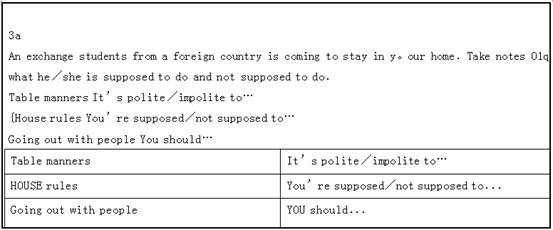
 答案:解析:Teaching Content: A class about how to writing.
答案:解析:Teaching Content: A class about how to writing.
Teaching Objectives:
(1) Knowledge objectives:
① Students will be able to know more Chinese customs, such as table manners, house rules, going out with people.
② Students can give some advice and suggestions about some Chinese customs to foreigners.
(2) Ability objective:
Students will improve their writing skills of giving advice and suggestions and improve the ability of communication.
(3) Emotional objectives:
① Students will have a deep understanding of the customs in our country.
② Students will foster their cross-cultural communication awareness.
Teaching Key Points:
How to give advice and suggestions on the rules of Chinese customs: table manners, house rules, going out with people.
Teaching Difficult Points:
How to master the expressions of Chinese customs and tell them to foreigners by letter.
Teaching Procedures:
Step 1 Pre-writing (10 minutes)
(1) Students are divided into ten groups. The teacher asks them to read 3a and discuss how to complete the chart. Then the students are asked to present their results and the teacher concludes their answers on the blackboard.
(2) Pair work
The teacher asks students to make a dialogue with their deskmates using the expressions:
①--What are the table manners
--It's polite/impolite to ...
②--What are the house rules
--You're supposed/not supposed to ...
③-How about going out with people
--You should ...
After the practice, the teacher invites two pairs to display their dialogue in the front of the class.
(Justification: This step can make students feel interested in the class and have things to write.)
Step 2 While-writing (15 minutes)
(1) Drafting
The teacher asks students to complete the letter of 3b according to the expressions in the chart. Then gives students 7 minuties to write the first draft.
(Justification: At this stage, the development of ideas are more important than getting grammatical structures, punctuation or spelling correct.)
(2) Peer editing
After the drafting, the teacher asks students to check each other's articles. They should read the notice and check the formation and the expressions. Also, they need to check carefully the grammar, spelling and punctuation of their writings. During the editing activity, the teacher offers guidance to students.
(Justification: Peer editing can provide an opportunity for students to share their writings and help them learn from each other. Proper guidance in revising can help students to know how to develop ideas and how to write clearly.)
Step 3 Post-writing (5 minutes)
The teacher invites two students to show their passages to all the students and gives them some evaluations.
Students will be encouraged to give some assessments too. Then the teacher asks students to revise their articles in both organisation and content based on the evaluations.
(Justification: At this stage, students can get some improvements in both organisation and contents. Revising their own articles can make them realize their mistakes more clearly.) -
第16题:
根据提供的信息和语言素材设计教学方案,用英文作答。
设计任务:请阅读下面学生信息和语言素材,设计一节20分钟的英语阅读活动。
教案没有固定格式,但须包含下列要点:?
teaching objectives
teaching contents
key and difficult points
major steps and time allocation
activities and justifications
教学时间:20分钟?
学生概况:某城镇普通中学七年级(初中一年级)学生,班级人数40人.多数学生已经达到《义务教育英语课程标准(2011年版)》二级水平,学生课堂参与积极性一般。
语言素材:
Mr. Cool's Clothes Store
Come and buy your clothes at our great sale! We sell all our clothes at very." good prices. Doyou like sweasters? We have green sweasters for only $15! Yellow sweasters for only $12! Do youneed trousers? For boys, we have black trousers for only $22. And shorts are only $16! For girls,we have skirts in purple for only $20. How much are our jackets? Only $30!And we have blackshoes for only $28. Socks are only $2 for three pairs!Come to Mr. Cool's Clothes Store now!答案:解析:Teaching Contents: An Advertisement about a clothes store.
Teaching Objectives:
(1) Knowledge objectives
Students can consolidate the sentence patterns "How much is ... It's ...""How much are these ... They're ...",master the phrase "at a good price" and become more familiar with the topic of shopping.
(2) Ability objectives
Students can ask about prices, talk about clothing, and use two reading strategies--skimming and scanning to get the information from the passage.
(3) Emotional objectives
Students will have a basic concept of consumption and their cooperative awareness will be improved.
Teaching Key Point:
How to guide students to use the two reading strategies--skimming and scanning to get the meaning of the passage.
Teaching Difficult Point:
How to use the reading strategy of scanning to get some specific information from sale ad.
Teaching Procedures :
Step 1 Pre-reading (5 minutes)
(1) Guessing
The teacher shows six clothing items and asks students to match each clothing item with a price.
1. a skirt __________ 2. a sweater __________3. socks __________
4. trousers__________ 5. shirts __________6. shoes __________
a.$3 b.$15 c.$20 d.$22 e.$25 f.$25
(2) The teacher shows a pair of nice shoes with the price of only $20 and a nice skirt priced at $10 on the screen.
T: If you buy something good in a low price, we can say this thing is at a good price.
Then the teacher teaches the phrase "at a good price". Students repeat the words after the teacher.
(3) The teacher asks students to pay attention to the picture and the title to predict the general idea of this passage. The teacher can ask some questions:
① What can you see in the picture
② Where are the clothes
③What's the store's name
Then the teacher encourages students to answer these questions.
(Justification: The guessing and prediction can make reading more intriguing. Teaching new phrase can make their reading much easier.)
Step 2 While-reading (9 minutes)
(1) Fast reading
T: Mr. Cool's Clothes Store has a great sale. Read the passage quickly and finish two tasks below.
① What's the main idea of the passage
②Check your guessing before.
Then the teacher checks the answers.
(2) Careful reading
According to the questions, the teacher draws a chart on the blackboard and asks students to read this ad again.
Then the teacher asks some students to fulfill the chart.
The teacher and the other students check the answers and give them some assessment.
(Justification: Fast reading can help students train their skimming skills. Filling out the table can make students pay more attention to the details of the passage, and it' s important for them to develop their scanning skills.)
Step 3 Post-reading (6 minutes)
(1) Pair work--Fill in the blanks.
T: Imagine you work at Mr. Cool's Clothes Store. Complete the conversation in pairs.
A: Hello,__________I help you
B: Yes, please. I need a __________
A: How about these purple __________
B: Oh, I like this one. How __________ is it
A: It's only __________ dollars.
B: Oh, good. I'll __________ it.
Then the teacher asks two pairs to show their dialogue to the class and gives them proper assessment.
(2) Group work--Discussion
The teacher divides the students into 8 groups and asks them to talk about what they should buy if they have $10. Then the teacher asks several students to show their ideas.
Then the teacher makes a summary:
When we go shopping, we should consider our purchasing power, and in our daily life, we should establish reasonable consumption habits.
(Justification: Pair work can help students practice how to ask about prices and talk about clothing. Group work provides students with an opportunity to communicate with others and practice their oral English.) -
第17题:
根据提供的信息和语言素材设计教学方案,用英文作答。
设计任务:请阅读下面学生信息和语言素材,设计20分钟的英语阅读教学方案。教案没有固定格式,但须包含下列要点:
·teaching objectives
·teaching contents
·key and difficult points
·major steps and time allocation
·activities and justifications
教学时间:20分钟
学生概况:某城镇普通中学七年级(初中一年级)学生。班级人数40人。多数学生已经达到《义务教育英语课程标准(2011年版)》二级水平,学生课堂参与积极性较高。 答案:解析:Teaching Contents: A passage about online shopping.
答案:解析:Teaching Contents: A passage about online shopping.
Teaching Objectives:
(1) Knowledge objectives
①Students can master the main idea of this passage.
②Students can learn the advantages and disadvantages of online shopping.
(2) Ability objective
Students can improve their reading and communicating abilities through class activities.
(3) Emotional objective
Students can improve their confidence of learning English*, and be not afraid of speaking English in class.
Teaching Key Points:
①Students can understand the advantages and disadvantages of online shopping.
②Students can comprehend the main idea of the passage.
Teaching Difficult Point:
Students can have a reasonable consumption online.
Major Steps:
Step 1 Pre-reading (6 minutes)
(1) Show some questions on the blackboard and ask students to have a discussion.
①Do you know how to buy something on the Internet
②Do you often buy things on the Interact
③What can you buy
(2) Ask students to predict the main idea of this passage.
(Justification: This step can arouse students' interest, and let them know the topic of this reading class.)
Step 2 While-reading (8 minutes)
(1) Fast reading
Ask students to read this short passage quickly in oneminute, and then conclude the main idea of each paragraph.
Ask students to examine their forecasts and conclude the main topic of this passage.
(Justification: Students can develop their skimming ability in this step.)
(2) Careful reading
Let students read this passage carefully again.
Show the table on the blackboard and ask students to discuss about the online shopping. Then ask some studentsto share their answers.
(Justification: Different ways of exploiting the text can help students not merely to cope with one particular textin class but to develop their reading strategies and reading ability.)
Step 3 Post-reading (6 minutes)
Choose two volunteers to have an interview about online shopping. One student acts as interviewer and the otherinterviewee. The knowledge they have learned in this class needs to be used in this interview.
(Justification: Students have the interview in their own way, which helps to make practical use of what they learnin this period. At the same time, students can have a better understanding of the topic.) -
第18题:
根据提供的信息和语言素材设计教学方案,用英文作答。
设计任务:请阅读下面的学生信息和语言素材,设计一个l5分钟的听说教学活动。
该方案没有固定格式,但须包含下列要点:?
teaching objectives
teaching contents
key and difficult points
major steps and time allocation
activities and justifications
学生概况:某城镇普通中学七年级(初一)学生,班级人数40人。多数学生已达到《义务教育英语课程标准(2011年版)》二级水平。学生课堂参与积极性一般。
语言素材:?
A: Is this your ruler?
B: No, it isn't. It's her ruler.
C: Is this your pencil?
D: Yes, it is. It's my pencil.答案:解析:Teaching Contents: This listening and speaking class is about the sentence pattern "Is this your ... "
Teaching Objectives:
(1) Knowledge objective
Students can recognize and read the new words about stationery--"pencil, ruler" and know how to use the sentence "Is this your ... ".
(2) Ability objective
Students can understand the sentence"Is this your ... " and use it to ask others about the ownership of something.
(3) Emotional objective
Students will be more interested in sharing their ideas with others and can cooperate with their partners well.
Teaching Key Point:
How to make students master the new words and new sentence structure.
Teaching Difficult Points:
(l) How to make students communicate with others correctly and fluently.
(2) How to make students get the key information after listening.
Teaching Procedures:
Step 1 Presentation and Practice (8 minutes)
Firstly, the teacher lets students listen to the tape recorder and try to guess the meaning of new words according to the pictures that the teacher shows them. After the first listening, the teacher teaches the new words "ruler,pencil". Students master the meaning and spelling of these words by missing-letter game.
Secondly, the teacher plays the tape again and leads students to pay attention to the conversation in the listening. After this listening, the teacher asks students the questions appeared in the recorder, like "Is this your pencil ls this your ruler " and encourages them to answer these questions by using the sentences they get during the listening.
(Justification: At this step, students can learn the meaning of the new words by pictures, and know how to read them by listening to the tape recorder. The missing-letter game can help students to participate in the class actively and practice the new words. The second listening activity can help students know how to use the new sentences and practice their listening skills.)
Step 2 Consolidation (7 minutes)
Pair work: The teacher asks students to play the dialogue in pairs, and encourages them to use more words of stationery. Then several pairs are asked to show their dialogues to the class, and the teacher will give them proper assessment on their presentations.
(Justification: This step can provide students with the opportunity to speak English in real situations and their speaking ability can also be improved.) -
第19题:
根据提供的信息和语言素材设计教学方案,用英文作答。
设计任务:请阅读下面学生信息和语言素材,设计一节英语语法课的教学方案。教案没有固定格式,但须包含下列要点:?
teaching objectives
teaching contents
key and difficult points
major steps and time allocation
activities and justifications
教学时间:45分钟?
学生概况:某城镇普通中学八年级(初中二年级)学生,班级人数40人,多数已经达到《义务教育英语课程标准(2011版)》三级水平,学生课堂参与积极性一般。
语言素材:?
Grammar:
A. It is + adj. + that ...
B. It is + adj. + to-infinitive
C. It is + adj. + for ... + to-infinitive答案:解析:【参考设计】
Teaching Contents: The sentence pettern"It is + adj. + that""It is + adj. + to-infinitive""It is + adj. + for sb. + to-infinitive".
Teaching Objectives:
(1) Knowledge objectives
①To use "It is + adj. + that" to say how one feels about sth.
② To use "It is + adj. + to-infinitive" to describe actions and situations.
③ To use "It is + adj. + for ... + to-infinitive" to specify the person one is talking about.
(2) Ability objective
Students can use "It is + adj. + that ...", "It is + adj. + to-infinitive" and "It is + adj. + for ... + to-infinitive" in daily communication.
(3) Emotional objective
Students can understand the differences between the Chinese language and English.
Teaching Key Points
(1) To use "It is +adj. + that" to say how one feels about sth.
(2) To use "It is + adj. + to-infinitive" to describe actions and situations.
(3) To use "It is + adj. + for ... + to-infinitive" to specify the person one is talking about.
Teaching Difficult Points
How to enable students to master the different uses of the following structures:
(1) It is + adj. + that ...
(2) It is + adj. + to-infinitive
(3) It is + adj. + for sb. + to-infinitive
Teaching Procedures:
Step 1 Lead-in (5 minutes)
Teacher show students a beautiful place of interest and two sentences:
It is interesting that there are so many beautiful flowers in the garden.
It is cool to spend our holiday here.
Ask students to guess their meaning and pay attention to the sentence pattern.
(Justification: The present of the beautiful place of interest and sentences can arouse students' interests in the class and help the teacher lead in the new teaching content.)
Step 2 Part A (10 minutes)
(1) Tell students that we use the "it is + adj. + that" structure to say bow we feel about something.
(2) Encourage them to ask questions if they are unsure of the meaning.
(3) Ask students to complete the exercises on their own.
(4) Ask some students to make some sentences using the adjectives and the given phrases.
① We can walk 100 kilometres in 45 hours. (possible)
② There are so many different trees in the parks. (interesting)
③ There was snow on one of the mountains. (surprising)
④ Each team must raise at least HK $6,000. (important)
⑤ So many people want to help others in need. (nice)
(Justification: This step makes students understand the structure"it is + adj. + that". Doing exercises can help students have a deep understanding of how the structure are formed and how they are used.)
Step 3 Part B (10 minutes)
(I) Explain that the"It is + adj. + to-infinitive" structure is similar to the structure students learned in Part A
except that here, the adjective describes an action or activity.
(2) Encourage students to ask questions if they are unsure of the meaning.
(3) Check that students have understood the structure.
(4) Ask students to make sentences using the given structure:
It is difficult to ...
It is easy to ...
It is exciting to ...
It is necessary to ...
(Justification: This step makes students understand and master this structure "It is + adj. + to-infinitive". The teacher in this step plays the role of organizer, resource-provider and assessor.)
Step 4 Part C (9 minutes)
(1) Explain that the structure in Part C is the same as the structure in Part B except that we insert"for sb."
between the adjective and the "to-infinitive" to indicate who we are talking about.
(2) Encourage students to ask questions if they are unsure of the meaning.
(3) Check that students have understood the structure.
(4) Ask students to make sentences using the given pictures and words.
①People should not go hiking alone. (dangerous)
②Jimmy's team can raise over HK $6,000 for charity. (possible)
③You can get very hot on the hike. (important/take lots of water)
(Justification: This step makes students understand and master this structure"It is + adj. + for ... + to-infinitive". Using picture prompts and words can help them practice the target language while negotiating meaning.)
Step 5 Practice (6 minutes)
Give students one topic--travel and ask them to make sentences in groups using the three sentence patterns.
Then ask some students to report their sentences.
(Justification: A real purpose for genuine communication among students can help them practice the language in a communicative way.)
Step 6 Summary and Homework (5 minutes)
Summary:
One student acts as an assistant teacher to guide all the students to summarize the new knowledge of this lesson.
Homework:
(1) Finish the exercises.
(2) Write a short story about your life including the grammar.
(Justification: Summary can help students consolidate the knowledge what they have learned in the class.
Homework makes students combine the grammar structure with their life, and practice their writing skills at the satne time.)
Blackboard Design:
1. It is + adj. + that clause
2. It is + adj. + to do sth
3. It is + adj. + for sb + to do sth
Teaching Reflection. -
第20题:
请认真阅读下列材料,并按要求作答。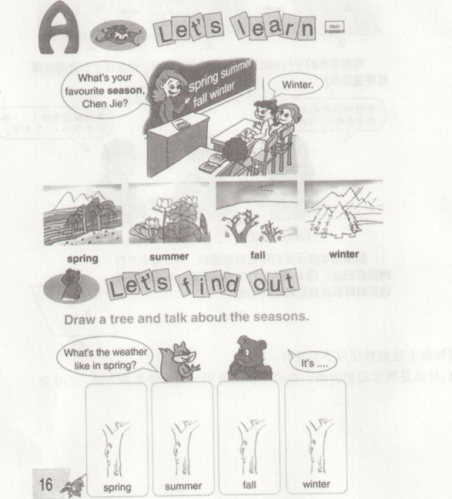
请根据上述材料完成下列任务:
(1)简述如何提高课堂活泼性。
(2)如指导小学生学习,试拟定教学目标。
(3)依据拟定的教学目标,设计导入和巩固环节的教学活动并说明设计理由。答案:解析:(1)提高课堂活泼性的措施 ①创设轻松、愉快的课堂环境。良好的课堂气氛能使学生的思维处于良好的状态,从而有助于提高学生参与课堂的积极性。
②选择适宜、合理的教学方法。不同年龄的学生有不同的认知特点,要针对学生的具体情况,灵活使用多种教学方法。例如使用游戏教学法会提高小学生参与课堂的主动性。
③使用生动、恰当的教学语言。教师生动、有趣的课堂语言能弥补一些教学内容本身的枯燥,使学生得到意想不到的乐趣,从而有助于提高其参与课堂学习的热情。
④采用形象、直观的教学手段。采用实物、模型、多媒体等直观教学的手段,可以集中学生的注意力,唤起学生学习的兴趣,有利于提高课堂活泼性。
⑤设计丰富、有趣的教学活动。小学生活泼好动,利用丰富、有趣的活动可以寓学于乐,激发学生的主动性。
(2) Teaching Aims
Knowledge aims: ① Students can learn the new words:spring, summer, fall, winter.
② Students can master the sentence pattern: What is your favorite season
Ability aim: Through cooperation and discussion, students can describe their favorite season and their listeningand speaking ability can be improved.
Emotional aim: Students' love for nature can be aroused.
(3)导入和巩固环节
Warming up and lead-in(导入环节):
①Daily greeting
T:What’sthe weather like today
Ss:It’s cool/cold/hot/warm…
②Ask students how many months and seasons there are in a year to lead in the new topic.
【设计意图】
通过与本课主题相关的日常问题问答.来拉近与学生之间的距离并激活学生已有的背景知识,为新授环节做好铺垫。
Consolidation(巩固环节):
Activity 1 :Do a survey
Let students find out their partners' favorite season using the new sentence they have learned and ask reasons,and then finish the chart.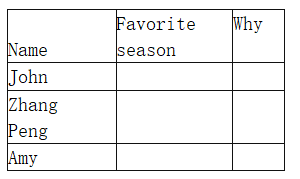
Activity 2:Draw a picture
According to their favorite season, each student should draw a picture and try to describe their pictures to others.
【设计意图】
通过小组调查和画画活动,能够增进学生之间彼此交流和了解,增强合作意识,并且能够巩固所学知识。 -
第21题:
请认真阅读下列材料,并按要求作答。

(1)请简述教师课堂上“创设语境”需要考虑的基本要素。
(2)请根据教学内容确定本课时的语言技能(听说)目标。
(3)请根据教学目标设计一个语言运用活动,并说明设计意图。(要求:创设一个真实语境,让学生运用核心句型以小组活动的形式进行语言交际训练。)答案:解析:(1)教师在课堂上“创设语境”需要考虑的基本要素有四点:
①创设语境要有针对性。创设语境要做到有的放矢、因材施教,所开展的活动目标、内容、方法及形式等都要适合学生的年龄特征、智力水平。
②创设语境要有趣味性。创设的语境要能够充分调动学生参与的积极性,使学生感知更加清晰、想象更加活跃、思维更加深刻、记忆更加牢固。
③创设语境要贴近生活。语境的创设要尽可能贴近学生生活,让学生有话可说,真正参与到教师所创设的语境中来。
培养学生运用所学的语言材料在特定的语言情景中的交际能力。
④创设语境要有可操作性。语境的创设要便于操作,不要超出教师的可控范围。
?(2)?Ability?objectives
①Students'?listening?and?speaking?ability?can?be?improved?by?the?end?of?the?class.
?②Students?can.?master?some?expressions?about?the?topic?"Lost&Found",?and?apply?them?in?real?situations.
?(?3?)?Practice&Activity
?Work?in?group?of?4,?and?give?each?group?an?empty?box?and?a"Lost&Found"?board.?Students?can?put?their?stationeries?in?the?empty?box.?Then?one?student?acts?as?an?office?staff;?other?students?come?to?him?to?get?their?lost?things?back.?For?example:
?A:?Exeuse?me.?I?lost?my?pencil?box.
?B:?What?color?is?it?
?A:?It's?red?and?blue.
?B:?OK.?What's?in?it?
?A:?Two?pencils,?a?pen,?a?ruler?and?an?eraser.
?B:?Here?it?is!
?A:?Thank?you?so?much.
?Students?will?have?10?minutes?to?complete?the?dialogue.?After?they?have?finished?the?group?work,?invite?one?or?two?groups?to
come?to?the?front?and?show?their?dialogues?to?the?whole?class.?Teacher?will?give?them?proper?feedback.
(设计意图:通过创设情境,让学生通过小组活动来练习单词和句型,可以提升学生的学习兴趣,使学生在合作交流的过程中巩固新知,增强合作意识。) -
第22题:
问答题根据提供的信息和语言素材设计教学方案,用英文作答。设计任务:请阅读下面学生信息和语言素材,设计20分钟的英语听力教学方案。该方案没有固定格式,但须包含下列要点:●teaching objectives●teaching contents●key and difficult points●major steps and time allocation●activities and justifications教学时间:20分钟学生概况:本班为中等城市普通学校初中一年级(七年级)学生,班级人数45人,多数学生已经达到《义务教育英语课程标准(2011年版)》二级水平。学生能够积极参与课堂活动,合作意识较强。语言素材: A: How much is the hat? B: The hat is six dollars. A: And how much are the shorts? B: Oh, they're eight dollars. A: And the sweater? How much iS the sweater? B: Let's see.The sweater is nine dollars.正确答案:解析: -
第23题:
问答题请简述阅读后阶段的教学任务是什么(6分)?该阶段可包括哪些活动(8分)?举例说明阅读后活动该如何设计(6分)。正确答案:解析: -
第24题:
问答题根据提供的信息和语言素材设计教学方案,用英文作答。 设计任务:请阅读下面学生信息和语言素材,设计20分钟的英语听说教学方案。 该方案没有固定格式,但须包含下列要点: • teaching objectives • teaching contents • key and difficult points • major steps and time allocation • activities and justifications 教学时间:20分钟 学生概况:某城镇普通中学初中一年级(七年级)学生,班级人数40人,多数学生已经达到《义务教育英语课程标准(2011年版)》二级水平。学生课堂参与积极性一般。 语言素材:正确答案:解析:
